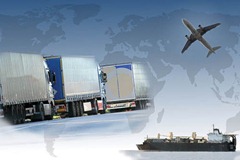Optimism for exporters
 Simon McKeever, Chief Executive of the Irish Exporters Association, details its ambitions for the future and the challenges that lie ahead.
Simon McKeever, Chief Executive of the Irish Exporters Association, details its ambitions for the future and the challenges that lie ahead.
Having spent 18 years in global financial markets, conducting business in the United Kingdom, Europe, the Middle East and Africa, Simon McKeever is confident that while challenges remain in export performance, there have been modest improvements.
McKeever emphasises the fact that “99.9 per cent of the world’s population don’t live on this island,” and adds: “I think that’s a really compelling reason to export.”
Exporting spreads risk. Whether these risks be economic, political, legislative or even seasonal, exporting “reduces the impact on your sales of being focused on one market only, in this case Ireland.” McKeever continues: “If you’re selling a product that that’s come to the end of its life-cycle in Ireland, there may be a market for it in a particular country overseas.”
Speaking on the financial and non-financial advantages recorded in the 2014 Export Ireland Survey, he notes that some new positives have emerged. For instance, companies which had begun to export reported an enhanced relationship with their banks, which in turn “increased and improved their ability to source finance.”
The principal benefits of export include the acquisition of expertise which can be applied to domestic market, enhanced competitiveness, and increased productivity which in turn produces efficiencies through economies of scale. McKeever states: “They ultimately should earn more money and be more profitable.”
While he concedes that a series of significant challenges face Irish exporters, he also highlights emerging opportunities. Some positive figures from the 2014 survey indicate that 71 per cent of companies reported an increase in exports. Furthermore, 25 per cent of these respondents reported an increase of over 15 per cent.
However, McKeever admits: “It’s not all great news. There are challenges to exporters out there.” A pervasive theme among these challenges is cost. Over
55 per cent of respondents declared an increase in costs during 2014. The Export Ireland survey emphasises that, where costs have increased, they have been above the average rate of inflation in Europe. Overall, the survey illustrates that cost-based factors contributed to a combined 43 per cent of the major challenges facing exporters.
A significant 13.6 per cent of respondents listed labour costs as the most acute challenge they faced. One subsequent outcome noted by McKeever is that “60 per cent have not recruited any new export development staff in 2014.”
Interestingly, though, McKeever highlights cultural and linguistic barriers as the rapidly emerging in-market challenge. “The region where most people are having difficulties is actually in the euro zone,” he adds, “particularly around the cultural area.”
Furthermore, access to finance, exchange rates and cash flow management problems continue to hinder exporters. Indeed 66 per cent of companies trading in dollars and pound sterling did not engage in hedging. Another 31 per cent invoiced in euros alone. Acknowledging that SMEs are more engaged in this, McKeever contends that “they’ve left themselves open to a huge exposure.”
 Other challenges facing exporters also related to contact with the finance sector. For instance, a failure on behalf of banks to understand the exporter’s business, a lack of security and numerous changes to a bank relationship team were all reported as factors in failure to obtain finance.
Other challenges facing exporters also related to contact with the finance sector. For instance, a failure on behalf of banks to understand the exporter’s business, a lack of security and numerous changes to a bank relationship team were all reported as factors in failure to obtain finance.
However, McKeever welcomed the fact that, when compared with 2013 survey responses, the recorded level of difficulty obtaining finance had actually decreased.
Most notably, in the field of research and development, the IEA found that a mere 42 per cent of exporters received support for their development processes. Moreover, 50 per cent of survey respondents stated that they had no awareness of any government support schemes for exporters – a figure described by McKeever as “quite astonishing.”
Though, he maintained: “This is a much more optimistic picture than we would have seen last year.” While a “hard core” 24 per cent of our respondents had difficulty getting finance from the banks, 60 per cent indicated that access to finance had improved.
Opportunities
The 2014 survey confirmed that, in the medium term (the next five years), Irish companies will continue to consider more traditional markets as the regions with better export opportunities. For example, North America, the UK, the euro zone and China are all identified as key markets, and this has remained “a reasonably consistent picture,” according to McKeever.
Conversely, there is a low perceived opportunity among Irish exporters in countries such as India, Japan and Mexico. “Mexico surprises me hugely,” he commented, “because it is a country that is growing very rapidly.”
The IEA survey indicates that the business experience of Irish companies trading in various countries is generally regarded as “borderline to positive”. The countries in which Irish exporters find it easiest to do business in are described by McKeever as those with historic ties to the former British Empire e.g. the United States, South Africa, Australia and Hong Kong.
Meanwhile, it is within the more distant markets such as Mexico that there is greatest growth. McKeever elaborates: “If you look at what the companies are doing in those economies, you can see that the further-flung markets are doing better.”
There is, therefore, an over-reliance on the three core markets of the United Kingdom, United States and the euro zone where approximately 80 per cent of exports are destined. “We need to do more to diversify that,” he adds. “We need to develop and grow indigenous Irish exports.”
Looking ahead, McKeever states: “We are working with a group of large Irish and non-Irish companies and a number of small companies to go out to the market and show people the benefits of it, educate them, and actually work to get them into the market along with the Department of Foreign Affairs and through the embassy network.”





